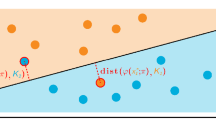Abstract
The paper discusses the possibility of implementing a minimum risk classifier using the learning machine approach. Necessary conditions on the choice of pairwise classification costs are imposed so that the minimum risk classifier can be implemented using pairwise class separating functions. Parameters of these functions are obtained using a two stage algorithm which minimizes a modified least squares criterion of class separation. In comparison to normal least squares objective function, this criterion increases the sensitivity of the learning scheme near the class separating surface and, consequently, allows for an improvement in the performance of the discriminant function decision making processor. Simplicity of the design procedure is achieved by partitioning the multimodal classes into unimodal subsets, since discriminant functions of unimodal classes can usually be implemented simply and with sufficient accuracy as low order polynomials. The proposed design approach is tested experimentally on an artificial pattern recognition problem.
Similar content being viewed by others
References
Fukunaga, K.: Introduction to statistical pattern recognition. New York: Academic Press 1972
Nilsson, N.J.: Learning machines. New York: McGraw-Hill 1965
Cover, T.M., Hart, P.E.: The nearest neighbour pattern classification. IEEE Trans. Inf. Theory IT-13, 21–27 (1967)
Specht, D.F.: Generation of polynomial discriminant functions for pattern recognition. IEEE Trans. Electr. Comp. EC-16, 308–319 (1967)
Mendel, J.M., Fu, K.S.: Adaptive, learning, and pattern recognition systems. New York: Academic Press 1970
Tsypkin, J.Z.: The foundations of the theory of learning systems. Moscow: Nauka 1970 (in Russian)
Dvoretzky, A.: On stochastic approximation. Proc. 3rd Berkeley Symp. on Math., Statistics and Probab. Berkely: University of California Press 1956
Wilde, D.J.: Optimum seeking methods. Englewood Cliffs, N.J.: Prentice Hall 1964
Tsypkin, J.Z.: Adaption and learning in automatic systems. New York: Academic Press 1971
Kendall, M.G., Staurt, A.: The advanced theory of statistics. London: Griffin 1961
Young, P.C.: Applying parameter estimation to dynamic systems. Control Engineering16, (1969)
Kittler, J., Young, P.C.: A new approach to feature selection based on the Karhunen-Loeve expansion. Pattern recognition5, 335–352 (1973)
Ivachnenko, A.G.: Heuristic selforganisation in problems of engineering cybernetics. Automatica6, 207–219 (1970)
Ball, G.H., Hall, D.J.: Isodata, a novel method of data analysis and pattern classification. Standford: Res. Inst. Techn. Report. 1965
Kittler, J.: Development and application of pattern recognition techniques. PhD thesis, Cambridge University (1974)
Young, P.C.: Recursive approach to time series analysis. Bull. Inst. Maths. Appl. (IMA)10, (1974)
Farison, J.B.: Statistical linearisation and variance estimation of products of functions of random variables with small variations. Proc. IEEE54, 1971–1972 (1966)
Author information
Authors and Affiliations
Rights and permissions
About this article
Cite this article
Kittler, J., Young, P.C. Discriminant function implementation of a minimum risk classifier. Biol. Cybernetics 18, 169–179 (1975). https://doi.org/10.1007/BF00326687
Received:
Issue Date:
DOI: https://doi.org/10.1007/BF00326687



